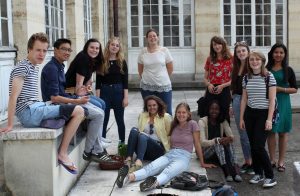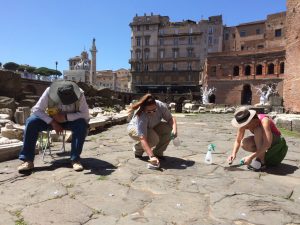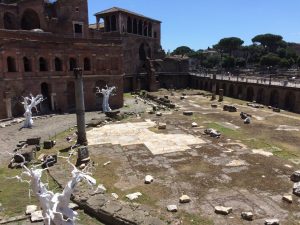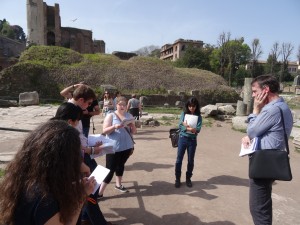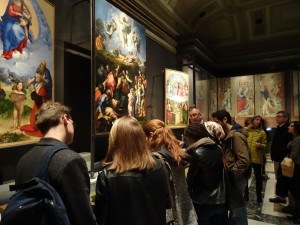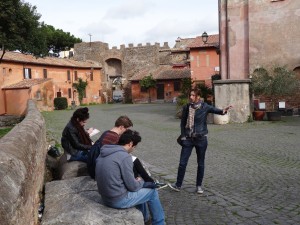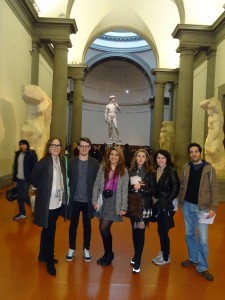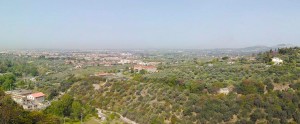
To coincide with the death of Raphael 496 years ago, the University of Kent held one of its annual European alumni events at the American University of Rome (AUR) on Wednesday 6 April 2016. This event was the second of a planned series of annual workshops building up to the 500th anniversary celebrations of Raphael’s death in 2020.
Two events took place at the University of Kent in Rome in April 2016; the first was a lecture delivered by Professor Arnold Nesselrath to mark the 496th anniversary of Raphael’s death, which presented the principal findings of the 30 year restoration campaign that he oversaw in the Raphael Stanze. This was then followed by a drinks reception. The next day, our Academic Director of Rome programmes, Professor Tom Henry, organised a study excursion to Tivoli for MA staff and students of Art History and Classics courses to mark the 500th anniversary of Raphael’s visit to Tivoli in April 1516. The study excursion visited the Sanctuary of Hercules Victor, the Villa d’Este and the Villa Adriana before returning to central Rome.
Professor Arnold Nesselrath’s lecture entitled “In the light of Raphael” focussed on how Raphael made use of light in different ways to convey emotion and depth. The lecture was well attended by AUR staff and students, alumni and University of Kent staff and was followed by a drinks and canape reception in the garden of AUR. This presented an excellent networking opportunity for guests to mingle and discuss the lecture over some delicious Roman catering!
The following day, the study excursion saw 35 students and staff board the coach to Tivoli, a city north-east of Rome. The first site we visited was the Sanctuary of Hercules Victor, only recently opened to the public in May 2015, located at the foot of Tivoli. Within the 3,000 square meters of the sanctuary is a large sacred area in the shape of a square, a theatre, and a temple which originally housed the statue of Hercules. The group then went on to the Villa d’Este, a Renaissance palace with stunning gardens and water fountains, which was originally built in 1550 for Cardinal Ippolito d’Este, the son of Lucrezia Borgia and Alfonso d’Este. The garden is designated a UNESCO World Heritage Site in recognition of its significance in the history of garden design, and its fountains find acclaim worldwide.
At this point, the group stopped for lunch at the Ristorante Sibilla, beside the Temple of Vesta. Lunch was served al fresco under a canopy of wisteria, looking out over the falls of the Aniene river in the blazing sunshine. Afterwards, the group walked around the Temple of Vesta and saw beautiful panoramic views down to the Villa Gregoriana. Our last visit was to the Villa Adriana, the site chosen by Emperor Hadrian for a huge palace set in acres of countryside. The group wandered around the extensive ruins which included a theatre, a stadium, many water features and thermal baths. Perhaps the most awe-inspiring site was the Canopus- a large rectangular pool measuring 121.4 metres long by 18 metres wide. The pool gained its name from an island in the Nile in Egypt that was the sanctuary of Serapis, the god of the Underworld, and is surrounded by chalk replicas of the original Roman copies of Greek sculptures from the Severa age.
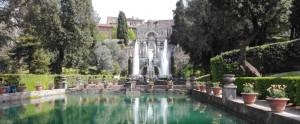
Both the lecture and study excursion attracted a number of academics from various institutions, which provided a valuable opportunity for students and indeed staff to discuss what Raphael would have seen on his visit to Tivoli. Each location throughout the study excursion prompted a new area of discussion and encouraged future collaborations between AUR and the University of Kent; such as developing studies in Renaissance Art and Classics programmes.
Dr Philippa Jackson wrote that “the mixture of expertise of the professors, the ability to discuss across humanistic disciplines and periods, and the enthusiasm of all was an exemplary example of the importance of site visits and time for discussion which have always aided the development of such studies. As a cultural historian I was particularly interested in the archaeological knowledge imparted and a chance to discuss matters of the Renaissance in the light of the classical past. I would like to thank everyone involved in the arrangement of the lecture at the American university and the trip to Tivoli.”

